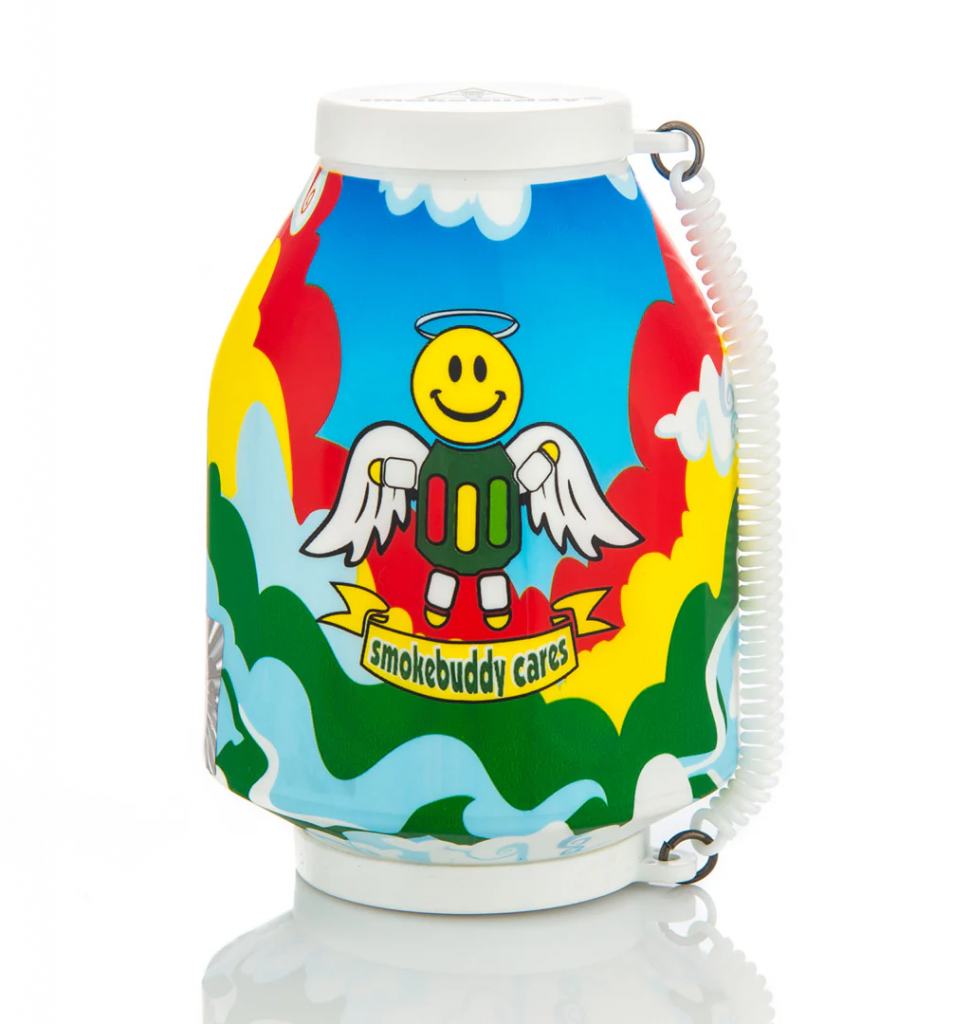When it comes to keeping your smoke session chill, discreet, and respectful to the people around you, personal air filters have become a staple. But with more smokers becoming eco-conscious, there’s a growing question in the air: eco-friendly vs regular personal air filters—what’s the real difference?
Is it just a marketing buzzword or are these two types of filters genuinely built different?
In this guide, we’ll break down the key differences. The reasons people are switching to eco-friendly options and how your choice can impact not just your experience, but also your surroundings and sustainability footprint.
Whether you’re new to personal air filters or looking to upgrade your setup, here’s what to know before you choose your next exhale tool.
Hold up— if you haven’t tried Smokebuddy yet, you’re missing out. Their personal smoke filters are top-tier. Use the code SLYNG23 to knock 20% off your bill.
Materials and Construction: What Are They Made Of?

The first thing that separates eco-friendly filters from regular ones is what they’re made of and how those materials affect the planet.
Eco-Friendly Filters Prioritize Sustainable Materials
Eco-friendly personal air filters are designed with environmental impact in mind. That means manufacturers use materials like recycled plastics, biodegradable shells, or plant-based components to reduce waste.
These filters are also often packaged in recyclable or compostable wrapping to lower their overall environmental footprint.
The goal is to create a filter that performs well without leaving a long-term trace in a landfill.
In some cases, components are even made from post-consumer recycled plastic, giving old materials a new life in a smoker-friendly format.
This type of build not only appeals to sustainability-minded users, it also provides peace of mind that your smoking accessories aren’t adding to global plastic pollution.
Regular Filters Focus on Function, Not Sustainability
Traditional personal air filters, on the other hand, typically use standard plastics and synthetic fibers without much attention to their long-term environmental impact.
They’re often disposable, single-use, or not intended to be recycled.
While many of these models offer great filtration and do their job effectively, they usually have a shorter lifespan and contribute more to waste.
The focus here is strictly on filtering smoke and odor without prioritizing sustainability.
This isn’t necessarily a flaw. It just reflects a different design philosophy. For users who don’t mind tossing out their filter after a few hundred hits, regular filters can still get the job done.
Durability and Lifespan: How Long Do They Last?
The next big difference comes down to how long each type of filter lasts and how that affects your experience.
Eco-Friendly Filters Are Built for the Long Haul
One major benefit of many eco-conscious filters is durability. They’re made to be reused over and over again, with strong casings, replaceable cores, and modular designs that extend their lifespan.
Some eco filters are rated for 300+ uses, and with proper care and cleaning, they often last even longer. That makes them a solid long-term investment for regular users, and it reduces how often you need to buy new gear.
This durability adds convenience, too. No more running out mid-week or tossing a half-used filter because the airflow feels off.
With the right maintenance routine, eco-friendly filters stay smooth and consistent for months.
Regular Filters May Be Single-Use or Shorter-Term
A lot of traditional filters are designed to be simple and disposable. Some are rated for 100–150 uses, while others are intended for single-session stealth. While this makes them convenient and low-maintenance, it also means they need replacing more often.
There’s a time and place for these models. Especially for casual users or situations where you don’t want to carry your main filter.
But if you’re looking for consistency and reliability over time, they can fall short.
More frequent replacements also mean more trips to the shop and more waste to dispose of, which adds up faster than you might expect.
Filtration Power: Do They Work the Same?
When it comes to actual performance, many people assume eco-friendly means a compromise. But that’s not the case.
Eco-Friendly Filters Hold Their Own in Performance
Just because a filter is eco-conscious doesn’t mean it’s any less effective.
Most eco-friendly models use advanced filtration media like activated carbon, ceramic beads, or HEPA-style layers to trap smoke, odor, and particulates.
These materials are non-toxic and effective at reducing smoke output.
The key difference is that these materials are often packaged in sustainable housings or recyclable casings. So you’re getting strong performance and environmental benefits in one.
Many users report no noticeable difference in performance between eco and non-eco filters when both are used properly and cleaned as needed.
In fact, some eco filters outperform traditional ones thanks to multi-layered, upgraded designs.
Regular Filters Rely on Tried-and-True Components
Traditional personal filters also use high-efficiency materials like carbon and fiber blends.
The biggest difference is in design: fewer modular or reusable parts, more single-use elements, and often less concern for end-of-life disposal.
That said, these filters often perform extremely well out of the box. They’re made to deliver consistent results for as long as their lifespan allows. Once they’re done, though, you usually toss the entire unit.
If convenience and simplicity are your top priorities, this might work for you. Just know that you may need to trade off reusability and sustainable construction.
Environmental Impact: What Happens After the Session?
This is where the difference between eco-friendly and regular filters becomes more than just about you. It’s about what happens after you’re done.
Eco-Friendly Filters Minimize Long-Term Waste
Many eco filters are designed with the product’s entire life cycle in mind.
That means minimal packaging waste, recyclable components, and longer usable life to reduce how often you need to replace them.
The end result? Less waste going into landfills, fewer plastics breaking down into microplastics, and a smaller environmental footprint over time. If you’re already trying to cut down on single-use items like water bottles, straws, and plastic bags, eco-friendly filters fit right into that mindset.
Some brands even offer return or recycling programs for used filter components, so you’re not left wondering what to do when it’s time to retire your gear.
Regular Filters Tend to Be Less Eco-Conscious
There’s nothing inherently “bad” about regular filters: they’re just not built with long-term sustainability as a priority. Once they’re done, they usually get tossed, with no option to recycle or repurpose the materials.
Multiply that by millions of smokers, and you’ve got a whole lot of plastic, fiber, and filter waste going into the environment year after year.
It’s not a crisis in one use. But it adds up when you consider global scale.
If sustainability is a key value for you, it’s worth factoring in the waste stream when choosing between filter types. The difference isn’t always visible, but it matters.
Cost and Value: Where’s the Smart Money?

Let’s talk dollars. Whether you’re budget-conscious or willing to spend for quality, understanding cost over time is key.
Eco-Friendly Filters Offer Long-Term Value
While the upfront cost for an eco-friendly filter might be higher than a standard model, the long-term math usually favors eco. You’re buying one well-built filter that you can use hundreds of times. Fewer replacements mean fewer purchases. That adds up.
Add to that the bonus of helping reduce waste and environmental harm, and it’s easy to see why so many users see eco filters as the better value over time.
It’s one of those “buy better, buy less” situations that just makes sense if you’re a frequent user.
With modular or refillable options, you can also extend lifespan further by replacing only the core rather than the whole device.
That’s more efficient both financially and environmentally.
Regular Filters Can Be Cheaper—But Add Up Fast
If you’re only using a filter occasionally, or if budget is tight, regular disposable models offer an affordable way to enjoy cleaner, more private sessions without breaking the bank.
But if you’re a daily user or close to it, those costs start stacking. Replacing a filter every couple of weeks ends up costing more than investing in one long-lasting eco model.
If you don’t mind the trade-offs, like more frequent purchases and less sustainability—regular filters might be the convenient choice.
But over time, they can be more expensive than they seem.
Final Thoughts: Is There Really a Difference?
The short answer? Yes—there’s a real difference between eco-friendly and regular personal air filters. From materials and longevity to environmental impact and cost, each type of filter brings a different set of benefits (and trade-offs) to the table.
If you’re all about long-term value, sustainability, and keeping your footprint light, eco-friendly filters are a smart upgrade. They offer performance, style, and a cleaner conscience all in one. But if your priority is convenience, one-and-done use, or lower initial costs, regular filters still deliver solid results.
The best choice depends on your lifestyle, how often you smoke, and what you value most in your gear. Either way, what matters is that your sessions stay smooth, respectful, and on your terms.
So, is there a difference? Absolutely. And now you’ve got the info to make the right move for your next clean exhale.
